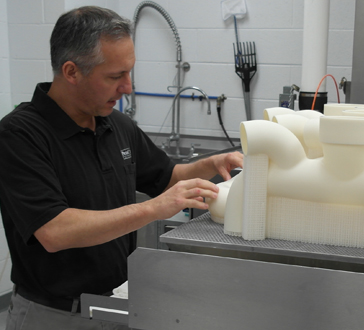Additive manufacturing – typically called just “3D printing” in the media – has taken on a cool factor. In fact, for a few thousand dollars (or less), anyone can buy their very own 3D printer. This kind of personal fabrication is trendy … but is it right for your projects?
There are a few cases where investing in an office-scale prototyping machine makes sense, but personal fabrication comes with a number of significant limitations that should be thoroughly evaluated before making the investment.
Carefully considering quality requirements, long-term quantity estimates, in-house capabilities, and ROI will give you a good snapshot of whether personal fabrication or service bureau benefits make the soundest business sense.
Quality: Negotiable or Necessary?
There are just two technologies available in consumer-scale rapid prototyping machines. Fused deposition modeling/FDM (also called fused filament fabrication or FFF) dominates the consumer market. It is the more widespread technique, but cannot match the build quality of other rapid prototyping techniques – even on an industrial scale.
Stereolithography/SLA is just emerging as a scaled-down technique, but hasn’t yet established a foothold. While professional SLA is a high-end, expensive technology, the single consumer version currently available offers a small build footprint and relatively low-quality end products.
The industrial-scale capabilities of a service bureau like ProtoCAM include dozens of available material and technology combinations, with results that range from fairly basic all the way to production-quality. Service bureau engineers understand and constantly implement the latest advances in rapid prototyping, and can even offer proprietary processes like ProtoCAM’s clear bottle finishes.
Skills and Scale
Many consumer-scale rapid prototyping machines are being positioned as user-friendly additions to the home or office. Fact is, in order to realize any return on investment, potential customers still need a specialized skillset to be able to set up, interface with and manage the machines.
Rapid prototyping operators need to be CAD-capable and prepared to safely handle caustic materials and chemicals, such as liquid resins. Although it’s advertised as accessible to the general public, additive manufacturing is never a plug-and-play process. That means it’s fine for hobbyists with time on their hands or dedicated design firms, but it’s unlikely that the average engineering department will be able to do much with personal fabrication.
Long-Term Cost
Throughput is also directly related to long-term cost. While there are some 3D printers for hobbyists available for under $1,000, consumer-scale machines for businesses typically run around $5,000. That’s cheap compared to the half-million dollar machines deployed by service bureaus – but before you invest, consider the fact that running a few small projects per year through a service bureau will likely run under $1,000. That total includes direct access to engineers and rapid prototyping specialists, fast turnaround times, zero need for machine maintenance … and a higher-quality end product than you’d get on your own.
Simply put, if you’re not putting a lot of parts through the machine, there is little reason to purchase your own. Think of that consumer-scale FDM machine like a treadmill; if it’s just going to turn into a place to hang your shirts, you might consider a gym membership instead.
Where Consumer-Scale Makes Sense
The best use case for consumer-scale rapid prototyping machines is for businesses that need to produce a few low-quality samples on a very regular basis, but it doesn’t lend itself to high volume or large size projects.
Design firms doing a lot of output, for example, may just need to get a general feel for the right size and shape of a concept. At this early stage, they’re not concerned about quality in terms of dimensional accuracy and a polished look; they just want to know if the idea seems right or wrong overall, and can tweak or built on the concept from there. Once the design is in a more finished form, they could then have it prototyped by a service bureau with industrial 3D printers.
For other users – especially those requiring only a few high-end parts – it makes far more sense to tap the knowledge, experience and innovation of a service bureau like ProtoCAM. The result is higher-quality finished pieces, delivered quickly, and always to spec. More than the pieces, however, the value of a service bureau lies in just that: “service.”
ProtoCAM: Excellence in Additive Manufacturing. Click here to get a quote for your rapid prototyping or additive manufacturing project today.
